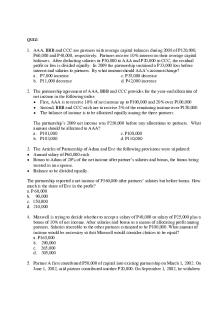Accounting Theories with Answers PDF

| Title | Accounting Theories with Answers |
|---|---|
| Course | BSA |
| Institution | Batangas State University |
| Pages | 3 |
| File Size | 63.9 KB |
| File Type | |
| Total Downloads | 32 |
| Total Views | 177 |
Summary
Drills PART I- THEORIES Which of the following should be considered cash?a. Certificate of Deposit b. Money orders c. Money market instruments d. Treasury bills What is compensating balance a. Saving account balance b. Loan account with bank c. Temporary investment servingas collateral for loan d. M...
Description
be
6. Which of the following could not be reported as cash or cash equivalents a. Money market accounts b. Demand deposits c. BSP treasury bills with an original maturity of sixty days from the date purchased d. Legally restricted deposit held as compensating balance against borrowing arrangement
2. What is compensating balance a. Saving account balance b. Loan account with bank c. Temporary investment serving as collateral for loan d. Minimum deposit required to be maintained in connection with borrowing arrangement
7. All of the following can be classified as cash and cash equivalents, except * a. Redeemable preference shares acquired and due in 60 days b. Commercial papers held and due for repayment in 90 days c. Equity investments d. A bank overdraft
3. Deposits held as compensating balance a. Usually do not earn interest b. If legally restricted and held against short-term credit may be included as cash c. If legally restricted and held against long-term credit may be included among current assets d. None of these
8. What is major purpose of an imprest petty cash fund a. To effectively plan cash inflows and outflows b. To ease the payment of cash to vendors c. To determine the honesty of the employees d. To effectively control cash disbursement
Drills PART I- THEORIES 1. Which of the following should considered cash? a. Certificate of Deposit b. Money orders c. Money market instruments d. Treasury bills
4. A cash equivalent is a short-term, highly liquid investment that is readily convertible into known amount of cash and a. Is acceptable as a means to pay current liabilities b. Has a market value greater than original cost c. Bears an interest rate that is at least equal to the prime interest rate d. Is so near maturity that it presents insignificant risk of change in interest rate. 5. Highly liquid investments that are readily convertible into cash can be shown as cash equivalents if the investments have a maturity of 90 days or less a. From the date the investments are acquired b. From the end of reporting period c. From the date of issue of financial statements d. From the date the investments are acquired or from the end of the reporting period
9. Which of the following statements in relation to petty cash fund is incorrect? a. Each disbursement from petty cash should be supported by a petty cash voucher b. The creation of a petty cash fund requires a journal entry to reflect the transfer of fund out of the general cash account c. At any time, the sum of the cash in the petty cash fund and the total of petty cash vouchers should equal the amount for which the imprest petty cash fund was established d. With the establishment of an imprest petty cash, one person is given the authority and responsibility for issuing checks to cover minor disbursements.
10. When an imprest petty cash fund is used, which of the following statements is true? a. The balance of the petty cash fund should be reported in the statement of financial position as a long-term investment b. The petty cashier’s summary of petty cash payments serves a journal entry that is posted as a long-term investment c. The reimbursement of the petty cash fund should be credited to the cash account d. Entries that include a credit to the cash account should be recorded at the time the payments from the patty cash fund are made. 11. If the balance shown in the bank statement is less than the correct cash balance and neither the entity nor the bank has made any errors, there must be a. Deposits credited by the bank but not yet recorded by the entity b. Outstanding checks c. Deposits in transit d. Bank charges not yet recorded by the entity 12. If the cash balance shown in the accounting records is less than the correct cash balance and neither the entity nor the bank has made any errors, there must be a. Deposits credited by the bank but not yet recorded by the entity b. Deposits in transit c. Outstanding checks d. Bank charges not yet recorded by the entity 13. Bank reconciliations are normally prepared on a monthly basis to identify adjustments needed in the depositor’s records and to identify bank errors. Adjustments on the part of the depositor should be recorded for a. Bank errors, outstanding checks and deposits in transit b. All items except bank errors, outstanding checks and deposits in transit c. Book errors, bank errors, deposit in transit and outstanding checks d. Outstanding checks and deposits and transit
14. Bank statements provide information about all of the following, except a. Checks cleared during the period b. NSF checks c. Bank charges for the period d. Errors made by the depositor 15. The ideal measure of short-term receivables is the discounted value of cash to be received in the future. Failure to follow this practice usually does not make the statement of financial position misleading because a. Most short-term receivables are noninterest bearing b. The allowance for uncollectible accounts includes a discount element c. The amount of the discount is not material d. Most receivables can be sold to a bank or factor 16. Which is more theoretically correct to record cash discount? a. Net approach b. Gross approach c. Allowance approach d. All three approaches are theoretically correct 17. All are problems associated with the valuation of accounts receivable, except a. Uncollectible accounts b. Returns c. Cash discounts under the net method d. Allowances granted 18. Which method of determining bad debt expense best achieves the matching concept? a. Percentage of sales b. Percentage of ending AR c. Percentage of average AR d. Direct write-off 19. When an entity uses the allowance method for recognizing doubtful accounts, the entry to record the writeoff of a specific uncollectible account a. Affects neither net income nor working capital b. Affects neither net income nor accounts receivable c. Decrease both net income and working capital d. Decrease both net income and accounts receivable...
Similar Free PDFs
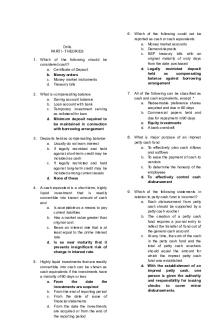
Accounting Theories with Answers
- 3 Pages
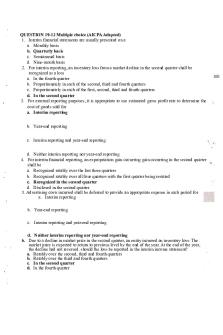
4 - Accounting Theories
- 4 Pages
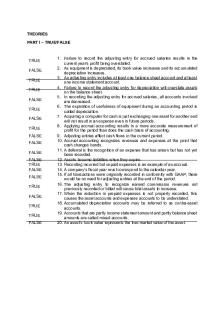
Theories on Accounting
- 4 Pages
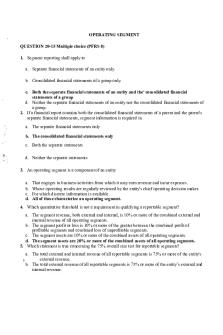
11 - Accounting Theories
- 11 Pages
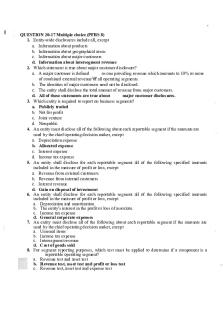
14 - Accounting Theories
- 3 Pages
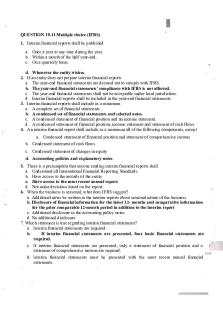
2 - Accounting Theories
- 4 Pages

Accounting Answers
- 3 Pages
Popular Institutions
- Tinajero National High School - Annex
- Politeknik Caltex Riau
- Yokohama City University
- SGT University
- University of Al-Qadisiyah
- Divine Word College of Vigan
- Techniek College Rotterdam
- Universidade de Santiago
- Universiti Teknologi MARA Cawangan Johor Kampus Pasir Gudang
- Poltekkes Kemenkes Yogyakarta
- Baguio City National High School
- Colegio san marcos
- preparatoria uno
- Centro de Bachillerato Tecnológico Industrial y de Servicios No. 107
- Dalian Maritime University
- Quang Trung Secondary School
- Colegio Tecnológico en Informática
- Corporación Regional de Educación Superior
- Grupo CEDVA
- Dar Al Uloom University
- Centro de Estudios Preuniversitarios de la Universidad Nacional de Ingeniería
- 上智大学
- Aakash International School, Nuna Majara
- San Felipe Neri Catholic School
- Kang Chiao International School - New Taipei City
- Misamis Occidental National High School
- Institución Educativa Escuela Normal Juan Ladrilleros
- Kolehiyo ng Pantukan
- Batanes State College
- Instituto Continental
- Sekolah Menengah Kejuruan Kesehatan Kaltara (Tarakan)
- Colegio de La Inmaculada Concepcion - Cebu








